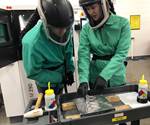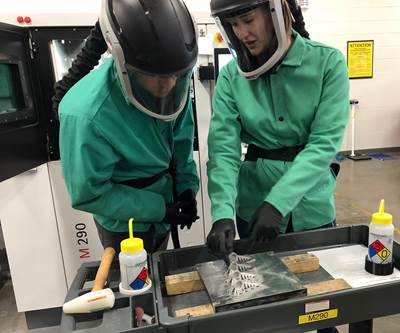How to Think About Design for Additive Manufacturing
It’s not as simple as changing the manufacturing method. True DFAM involves tradeoffs, specialization and even failure.
The mandate to implement "design for additive manufacturing" (or neatly abbreviated: DFAM) is not as simple as designing a part to be built additively. The ideal DFAM workflow is actually recursive—it must exist in a feedback loop that includes not only the additive process, but also the material to be used, the parameters of the machine, postprocessing needs, and the essential properties and function of the part.
A recent DFAM seminar touched on all stages of the additive process. Hosted by SME as part of its Smart Manufacturing seminar series, the event took place in Knoxville, Tennessee. (View the schedule and register for future events here.) Over the course of a day, industry experts from AM equipment suppliers, users and national labs spoke about the challenges of designing for additive in the context of their organizations.
Here are some of the themes that emerged:
True DFAM starts with a “clean sheet of paper.” Brian Levy, design engineer for Joe Gibbs Racing, made this point in talking about his company’s experience moving from traditional manufacturing to AM on many custom racecar parts. He says the engineering team had to learn by experience that they couldn’t just print off a replacement of an existing CAD part and expect it to function the same way as the machined part. Instead, they've learned to start with a blank page for additive parts, redesigning rather than adapting, while taking into consideration the material and the machine to be used. In some cases this means designing a part that will print successfully on more than one system, he says, citing a series of dashboard inserts that were originally designed for an FDM system, but later tested and produced successfully on an Objet printer as well.
Josh Mook, engineering leader of GE Additive, illustrated the idea of starting from scratch in telling the story of how a team of GE engineers was challenged to redesign a helicopter engine in secret. The goal, he says, was not to pull specific parts off the engine and 3D print them. Instead, the team was challenged to "set the architecture of the engine around additive." By redesigning the complete system from the ground up, GE was able to take advantage of opportunities to consolidate parts and eliminate seals; as a result of their work and the complexity enabled by AM, the new engine included a sand removal system that could increase the lifespan of the engine in a desert environment from 6 months to 2 years.
Additive manufacturing thrives on failure. During the Q&A segment following his talk, Paul Zwart, market development consultant for AM at Caterpillar, was asked how the company deals with failure. Zwart answered that his team strives to look at failures as a learning experience. When you come to see the failure as a positive, you can capture that knowledge for next time, he says.
If any organization in the AM space is adept at this type of knowledge capture, it's Oak Ridge National Laboratory (ORNL). During his talk, Dr. Brian K. Post, associate research staff member at ORNL, recounted the process for designing and building the Strati, the 3D-printed car that was created using Cincinnati Inc.'s Big Area Additive Manufacturing (BAAM) system. After explaining some key changes that were made in the process—such as removing the fenders of the car because they were cooling too quickly compared to the rest of the build, and increasing the extrusion rate of the BAAM system—Post shared that the first successful build of the Strati was the one that happened on the show floor at IMTS 2014. Careful observation and analysis of previous builds made this public test a success.
Tradeoffs are part of the process. Though AM can build intricate, complex shapes, these don’t necessarily come without their own cost. According to Levy, there’s a tradeoff between wanting a light part with thin walls and ensuring that it can actually support the loads it will be subjected to. In some cases extra supports, thicker walls or other design features may be necessary. One of the examples given in his talk was a visor custom-made for a race car driver. The design was based on another driver's visor, but was taller than the original. In order to strengthen and keep the visor from cracking, it was necessary to add internal supports that hadn't been necessary in the first design.
Specifics are specialized. There are some lessons that can be applied broadly to most additive technologies, but detailed design advice is heavily dependent on the material and process used, as well as the part's intended function.
Evan Kuester, applications engineer for 3D Systems, showcased multiple examples of parts made using selective laser sintering (SLS) in his talk. One of these applications was the 3D printing of very thin "egg shell" molds for silicon casting. The shells are injected with silicon, and then broken to release the flexible part. Though the printer is capable of finer resolution that would be suitable for other parts, for this application Kuester recommends no thinner than 0.3-mm wall thickness to support the injection molding process, based on iterative design work. Without the context of the application, it's still difficult to make specific recommendations for AM.
DFAM requires “enterprise-level disruption.” This is how Josh Mook described the changes that have been happening at GE in the wake of additive manufacturing. He is the engineering leader GE Additive, the newest business unit at GE, a unit that indicates AM’s disruption with its very existence. But this disruption is about more than business units and reorganization; the way that GE is approaching product development in all of its product lines and industries is changing. In the past, Mook explained, a product might have 300 components, take 60 engineers to design and execute, use more than 50 manufacturing sources and 5 repair sources, and integrate 40 data systems. Using a DFAM approach, that same component could be made as just one part, designed by six to eight engineers, using just one manufacturing source and inspection system, one service shop, and one data lake powered by GE's Predix system.
Other presenters touched on the need for organization-wide disruption as well. Zwart explained how Caterpillar lacks a central group working on additive manufacturing; instead the company has a central "hub" in its 3D Printing Group, which feeds out information to various spokes—the research, product design and aftermarket groups. Even so, it's difficult to change the thinking of thousands of employees spread worldwide.
"How do you inspire 10,000 design engineers in multiple facilities across the globe?" asks Zwart. One method Caterpillar uses is an annual design challenge, in which engineers are tasked with redesigning a component that could be improved via additive manufacturing. Zwart highlighted the winner of the 2016 challenge, a ball check valve for a thermal test rig that was prone to leaking. The redesign eliminated the leaks by consolidating the valve's five parts into just one additive build. As a result, the cost of the part dropped by 55 percent, 33 percent of pressure drop was eliminated and noise was reduced. The challenge promotes additive thinking across the organization while generating real results.
Topology optimization must be customized for AM. Topology optimization was a major topic throughout the day, as might be expected at a seminar related to additive manufacturing. Raymond Wildman, materials research engineer at the U.S. Army Research Laboratory made the point that while the two go hand-in-hand, topology optimization is broader than just additive manufacturing. It's a computational design method that uses an optimization loop to solve a given physics problem, and that solution may or may not be buildable with current additive technologies. As a result, Wildman calls for adapting topology optimization to additive manufacturing by focusing on the factors most critical to AM success: minimizing feature size, eliminating support structures and reducing residual stress. By controlling these variables, it's possible to make topology optimization more productive for additive applications.
In the future, much of DFAM will be automated. Dovetailing with Wildman's presentation, Dr. Ted D. Blacker, manager of simulation modeling sciences at Sandia National Laboratories, detailed how topology optimization and simulation could lead to more advanced design methods. Blacker's lab is involved in the development of a software package known as PLATO, or Platform for Topology Optimization. The package combines design capabilities with calculation simulation and immediate feedback for designers.
The goal, Blacker says, is to "turn the analysis and design scenario on its head." With existing platforms, designers must provide a design in order to make a mesh and start simulations, which are then analyzed so that adjustments can be made. With PLATO, it will be possible to work with the physics from the beginning to create the shape of the part, he says. Placing this burden on the software will help engineers move away from being analysts and lead to more creative designs that are optimized for additive manufacturing from the very beginning.
Related Content
10 Important Developments in Additive Manufacturing Seen at Formnext 2022 (Includes Video)
The leading trade show dedicated to the advance of industrial 3D printing returned to the scale and energy not seen since before the pandemic. More ceramics, fewer supports structures and finding opportunities in wavelengths — these are just some of the AM advances notable at the show this year.
Read MoreHow to Improve Polymer AM Productivity 20X
A fast cycle time is critical to efficient production 3D printing, but it’s not the only thing. How you choose the right parts for AM, prepare jobs for production, and manage post processing will have just as big an impact on total 3D printing throughput. It all needs to work together to achieve maximum productivity.
Read MoreAM 101: NanoParticle Jetting (NPJ)
The proprietary process from XJet builds ceramic and metal parts using nanoparticle suspensions. Learn how NPJ works in this introductory article, part of our AM 101 series.
Read MoreHow to Build 10,000+ Shot Molds in Hours
Rapid tooling isn’t so rapid when it takes days to 3D print a metal mold, and then you still must machine it to reach the necessary tolerances. With Nexa3D’s polymer process you can print a mold in hours that is prototype or production ready and can last for more than 10,000 shots.
Read MoreRead Next
How to Implement Additive Manufacturing Across a Global Company: 5 Lessons
With more than 100 facilities and about 200,000 employees worldwide, Flex has a steep challenge in bringing 3D printing into its operations. Five things the company is learning.
Read More6 Things I Learned about Metal 3D Printing at the AMIST
I sat in on one and a half days of a five-day class offered at the Additive Manufacturing Institute of Science and Technology (AMIST) in Louisville. Here’s just some of what I learned.
Read More3D Printing Brings Sustainability, Accessibility to Glass Manufacturing
Australian startup Maple Glass Printing has developed a process for extruding glass into artwork, lab implements and architectural elements. Along the way, the company has also found more efficient ways of recycling this material.
Read More
.jpg;width=70;height=70;mode=crop)




















